Effect of Combustor Outlet Geometry on Operating Characteristics of Disk-Shaped Rotating Detonation Engine
Abstract
:1. Introduction
2. Materials and Methods
3. Results
3.1. Effect of Convergent Ratio on RDW Propagating Process and Parameters
3.2. Effect of Convergent Ratio on RDW Propagation at Higher Mass Flow Rates
3.3. Effect of Convergent Ratio on RDE Operation Mode
3.4. Effect of Convergent Ratio on RDE Operation Range
3.5. Effect of Outlet Length on RDW Propagating Characteristic
4. Conclusions
Author Contributions
Funding
Data Availability Statement
Conflicts of Interest
Nomenclature
| RDE | Rotating detonation engine |
| RDC | Rotating detonation combustor |
| RDW | Rotating detonation wave |
| DDT | Detonation to Detonation Transition |
| SW | Single-wave mode |
| SDW | Symmetric dual-wave mode |
| ADW | Asymmetric dual-wave mode |
| USW | Unstable single-wave mode |
| F | Failure initiation |
| SW/ADW | Single-wave and asymmetric dual-wave mode |
| ADW/SDW | Asymmetric dual-wave and symmetric dual-wave mode |
| LFI | Low frequency instability |
| CR | Convergent ratio |
| ER | Equivalence ratio |
| p1p | Pressure peak |
| v1 | Velocity |
References
- Ge, G.; Deng, L.; Ma, H.; Xia, Z.; Liu, X.; Zhou, C. Effect of high-pressure detonation products on fuel injection and propagation characteristics of detonation wave. Propuls. Power Res. 2022, 11, 58–73. [Google Scholar] [CrossRef]
- Goto, K.; Nishimura, J.; Kawasaki, A.; Matsuoka, K.; Kasahara, J.; Matsuo, A.; Funaki, I.; Nakata, D.; Uchiumi, M.; Higashino, K. Propulsive performance and heating environment of rotating detonation engine with various nozzles. J. Propuls. Power 2019, 35, 213–223. [Google Scholar] [CrossRef]
- Ivanov, V.S.; Frolov, S.M.; Zangiev, A.E.; Zvegintsev, V.I.; Shamshin, I.O. Hydrogen fueled detonation ramjet: Conceptual design and test fires at Mach 1.5 and 2.0. Aerosp. Sci. Technol. 2021, 109, 106459. [Google Scholar] [CrossRef]
- Frolov, S.M.; Zvegintsev, V.I.; Ivanov, V.S.; Aksenov, V.S.; Shamshin, I.O.; Vnuchkov, D.A.; Nalivaichenko, D.G.; Berlin, A.A.; Fomin, V.M.; Shiplyuk, A.N.; et al. Hydrogen-fueled detonation ramjet model: Wind tunnel tests at approach air stream Mach number 5.7 and stagnation temperature 1500 K. Int. J. Hydrogen Energy 2018, 43, 7515–7524. [Google Scholar] [CrossRef]
- Huff, R.T.; Boller, S.A.; Polanka, M.D.; Schauer, F.R.; Fotia, M.L.; Hoke, J.L. Radial rotating detonation engine driven bleed air turbine. J. Propuls. Power 2021, 37, 252–260. [Google Scholar] [CrossRef]
- Naples, A.; Hoke, J.; Battelle, R.; Schauer, F. T63 turbine response to rotating detonation combustor exhaust flow. J. Eng. Gas Turbines Power 2019, 141, 021029. [Google Scholar] [CrossRef]
- Hansmetzger, S.; Zitoun, R.; Vidal, P. A study of continuous rotation modes of detonation in an annular chamber with constant or increasing section. Shock Waves 2018, 28, 1065–1078. [Google Scholar] [CrossRef]
- Anand, V.; St. George, A.; Gutmark, E. Hollow Rotating Detonation Combustor. In Proceedings of the 54th AIAA Aerospace Sciences Meeting, San Diego, CA, USA, 4–8 January 2016. [Google Scholar] [CrossRef]
- Bykovskii, F.A.; Zhdan, S.A.; Vedernikov, E.F.; Samsonov, A.N.; Popov, E.L. Detonation of a hydrogen-oxygen gas mixture in a plane-radial combustor with exhaustion toward the periphery in the regime of oxygen ejection. J. Phys. Conf. Ser. 2018, 1128, 012075. [Google Scholar] [CrossRef]
- Kindracki, J.; Wolański, P.; Gut, Z. Experimental research on the rotating detonation in gaseous fuels–oxygen mixtures. Shock Waves 2011, 21, 75–84. [Google Scholar] [CrossRef]
- Kindracki, J. Experimental research on rotating detonation in liquid fuel–gaseous air mixtures. Aerosp. Sci. Technol. 2015, 43, 445–453. [Google Scholar] [CrossRef]
- Xu, G.; Wu, Y.; Xiao, Q.; Ding, C.; Xia, Y.; Li, Q.; Weng, C. Characterization of wave modes in a kerosene-fueled rotating detonation combustor with varied injection area ratios. Appl. Therm. Eng. 2022, 212, 118607. [Google Scholar] [CrossRef]
- Yan, C.; Teng, H.; Ng, H.D. Effects of slot injection on detonation wavelet characteristics in a rotating detonation engine. Acta Astronaut. 2021, 182, 274–285. [Google Scholar] [CrossRef]
- Bykovskii, F.A.; Zhdan, S.A.; Vedernikov, E.F. Continuous spin detonation of fuel–air mixtures. Combust. Explos. Shock. Waves 2006, 42, 463–471. [Google Scholar] [CrossRef]
- Kawasaki, A.; Inakawa, T.; Kasahara, J.; Goto, K.; Matsuoka, K.; Matsuo, A.; Funaki, I. Critical condition of inner cylinder radius for sustaining rotating detonation waves in rotating detonation engine thruster. Proc. Combust. Inst. 2019, 37, 3461–3469. [Google Scholar] [CrossRef]
- Bykovskii, F.A.; Zhdan, S.A.; Vedernikov, E.F. Continuous spin detonations. J. Propuls. Power 2006, 22, 1204–1216. [Google Scholar] [CrossRef]
- Bykovskii, F.A.; Zhdan, S.A.; Vedernikov, E.F. Continuous spin detonation of hydrogen-oxygen mixtures.1. annular cylindrical combustors. Combust. Explos. Shock 2008, 44, 150–162. [Google Scholar] [CrossRef]
- Lin, W.; Zhou, J.; Liu, S.; Lin, Z.; Zhuang, F. Experimental study on propagation mode of H2/air continuously rotating detonation wave. Int. J. Hydrogen Energy 2015, 40, 1980–1993. [Google Scholar] [CrossRef]
- Katta, V.R.; Cho, K.Y.; Hoke, J.L.; Codoni, J.R.; Schauer, F.R.; Roquemore, W.M. Effect of increasing channel width on the structure of rotating detonation wave. Proc. Combust. Inst. 2019, 37, 3575–3583. [Google Scholar] [CrossRef]
- Schwer, D.A.; Kailasanath, K. Numerical study of the effects of engine size on rotating detonation engines. In Proceedings of the 49th AIAA Aerospace Sciences Meeting including the New Horizons Forum and Aerospace Exposition, Orlando, FL, USA, 4–7 January 2011. [Google Scholar] [CrossRef]
- Zhou, R.; Wang, J.P. Numerical investigation of shock wave reflections near the head ends of rotating detonation engines. Shock Waves 2013, 23, 461–472. [Google Scholar] [CrossRef]
- Fan, W.-J.; Liu, W.-D.; Peng, H.-Y.; Liu, S.-J.; Sun, J. Numerical study on ethylene-air continuous rotating detonation in annular combustors with different widths. J. Zhejiang Univ. A 2022, 23, 388–405. [Google Scholar] [CrossRef]
- Zhu, Y.; Wang, K.; Zhao, M.; Wang, Z.; Fan, W. Experimental study on wave propagations in a rotating detonation chamber with different outlet configurations. Acta Astronaut. 2022, 200, 388–399. [Google Scholar] [CrossRef]
- Wolański, P.; Balicki, W.; Perkowski, W.; Bilar, A. Experimental research of liquid-fueled continuously rotating detonation chamber. Shock Waves 2021, 31, 807–812. [Google Scholar] [CrossRef]
- Zhao, M.; Wang, K.; Zhu, Y.; Wang, Z.; Yan, Y.; Wang, Y.; Fan, W. Effects of the exit convergent ratio on the propagation behavior of rotating detonations utilizing liquid kerosene. Acta Astronaut. 2022, 193, 35–43. [Google Scholar] [CrossRef]
- Deng, L.; Ma, H.; Xu, C.; Liu, X.; Zhou, C. The feasibility of mode control in rotating detonation engine. Appl. Therm. Eng. 2018, 129, 1538–1550. [Google Scholar] [CrossRef]
- Tang, X.; Wang, J.; Shao, Y. Three-dimensional numerical investigations of the rotating detonation engine with a hollow combustor. Combust. Flame 2015, 162, 997–1008. [Google Scholar] [CrossRef]
- Yao, S.; Tang, X.; Luan, M.; Wang, J. Numerical study of hollow rotating detonation engine with different fuel injection area ratios. Proc. Combust. Inst. 2017, 36, 2649–2655. [Google Scholar] [CrossRef]
- Zhang, H.; Liu, W.; Liu, S. Effects of inner cylinder length on H2/air rotating detonation. Int. J. Hydrogen Energy 2016, 41, 13281–13293. [Google Scholar] [CrossRef]
- Zhang, H.; Jiang, L.; Liu, W.; Liu, S. Characteristic of rotating detonation wave in the H2/Air hollow chamber with Laval nozzle. Int. J. Hydrogen Energy 2021, 46, 13389–13401. [Google Scholar] [CrossRef]
- Liu, S.-J.; Huang, S.-Y.; Peng, H.-Y.; Yuan, X.-Q. Characteristics of methane-air continuous rotating detonation wave in hollow chambers with different diameters. Acta Astronaut. 2021, 183, 1–10. [Google Scholar] [CrossRef]
- Rong, G.; Cheng, M.; Sheng, Z.; Liu, X.; Zhang, Y.; Wang, J. The behavior of the propagating velocity of rotating detonation waves and counter-rotating shock waves in a hollow combustor. Acta Astronaut. 2022, 200, 371–387. [Google Scholar] [CrossRef]
- Sun, J.; Zhou, J.; Liu, S.; Lin, Z.; Lin, W. Numerical investigation of a non-premixed hollow rotating detonation engine. Int. J. Hydrogen Energy 2019, 44, 17084–17094. [Google Scholar] [CrossRef]
- Bykovskiĭ, F.A.; Zhdan, S.A.; Vedernikov, E.F.; Zholobov, Y.A. Continuous and pulsed detonation of a coal-air mixture. Dokl. Phys. 2010, 55, 142–144. [Google Scholar] [CrossRef]
- Bykovskii, F.A.; Zhdan, S.A.; Vedernikov, E.F.; Zholobov, Y.A. Continuous spin detonation of a coal-air mixture in a flow-type plane-radial combustor. Combust. Explos. Shock. Waves 2013, 49, 705–711. [Google Scholar] [CrossRef]
- Bykovskii, F.A.; Zhdan, S.A.; Vedernikov, E.F.; Zholobov, Y.A. Detonation of a coal-air mixture with addition of hydrogen in plane-radial vortex chambers. Combust. Explos. Shock. Waves 2011, 47, 473–482. [Google Scholar] [CrossRef]
- Paxson, D.E. Preliminary computational assessment of disk rotating detonation engine configurations. In Proceedings of the AIAA Scitech 2020 Forum, Orlando, FL, USA, 6–10 January 2020. [Google Scholar] [CrossRef]
- McClearn, M.J.; Schauer, F.R.; Huff, R.; Polanka, M.D.; Hoke, J.L.; Fotia, M. A disk rotating detonation engine part 2: Operation. In Proceedings of the 2018 AIAA Aerospace Sciences Meeting, Kissimmee, FL, USA, 8–12 January 2018. [Google Scholar] [CrossRef]
- Huff, R.; Polanka, M.D.; McClearn, M.J.; Schauer, F.R.; Fotia, M.L.; Hoke, J.L. Design and operation of a radial rotating detonation engine. J. Propuls. Power 2019, 35, 1143–1150. [Google Scholar] [CrossRef]
- Watanabe, T.; Jourdaine, N.H.; Ozawa, K.; Tsuboi, N.; Kojima, T.; Hayashi, K.A. Numerical Simulation on Disk Rotating Detonation Engine: Influence of Internal Flow Field Structure on Performance. In Proceedings of the AIAA Scitech 2020 Forum, Orlando, FL, USA, 6–10 January 2020. [Google Scholar] [CrossRef]
- Ishiyama, C.; Miyazaki, K.; Nakagami, S.; Matsuoka, K.; Kasahara, J.; Matsuo, A.; Funaki, I. Experimental Study of Research of Centrifugal-Compressor-Radial-Turbine Type Rotating Detonation Engine. In Proceedings of the 52nd AIAA/SAE/ASEE Joint Propulsion Conference, Salt Lake City, UT, USA, 25–27 July 2016. [Google Scholar] [CrossRef]
- Huff, R. Design, Buildup, and Testing of a Radial Rotating Detonation Engine for a Compact Auxiliary Power Unit; Air University: Wright-Patterson Air Force Base, OH, USA, 2018. [Google Scholar]
- Higashi, J.; Ishiyama, C.; Nakagami, S.; Matsuoka, K.; Kasahara, J.; Matsuo, A.; Funaki, I.; Moriai, H. Experimental Study of the Disk-Shaped Rotating Detonation Turbine Engine. In Proceedings of the 55th AIAA Aerospace Sciences Meeting, Grapevine, TX, USA, 9–13 January 2017. [Google Scholar] [CrossRef]
- Kawalec, M.; Perkowski, W.; Łukasik, B.; Bilar, A.; Wolański, P. Applications of the continuously rotating detonation to combustion engines at the Łukasiewicz-Institute of Aviation. Combust. Engines 2022, 191, 51–57. [Google Scholar] [CrossRef]
- Kawalec, M.; Wolański, P. Development of Rocket Engine with Continuously Rotating Detonation supplied by Liquid Propellants. In Proceedings of the 9th European Conference for Aeronautics and Space Sciences (EUCASS), Lille, France, 27 June–1 July 2022. [Google Scholar] [CrossRef]
- Nakagami, S.; Matsuoka, K.; Kasahara, J.; Matsuo, A.; Funaki, I. Experimental study of the structure of forward-tilting rotating detonation waves and highly maintained combustion chamber pressure in a disk-shaped combustor. Proc. Combust. Inst. 2017, 36, 2673–2680. [Google Scholar] [CrossRef]
- Nakagami, S.; Matsuoka, K.; Kasahara, J.; Matsuo, A.; Funaki, I. Visualization of Rotating Detonation Waves in a Plane Combustor with a Cylindrical Wall Injector. In Proceedings of the 53rd AIAA Aerospace Sciences Meeting, Kissimmee, FL, USA, 5–9 January 2015. [Google Scholar] [CrossRef]
- Frolov, S.M.; Shamshin, I.O.; Aksenov, V.S.; Ivanov, V.S.; Vlasov, P.A. Ion sensors for pulsed and continuous detonation combustors. Chemosensors 2023, 11, 33. [Google Scholar] [CrossRef]
- Xia, Z.; Ma, H.; Ge, G.; Liu, S.; Zhou, C.; He, Y. Visual experimental investigation on stable operating process of the plane-radial rotating detonation engine. Aerosp. Sci. Technol. 2021, 109, 106430. [Google Scholar] [CrossRef]
- Xia, Z.; Ma, H.; Liu, C.; Zhuo, C.; Zhou, C. Experimental investigation on the propagation mode of rotating detonation wave in plane-radial combustor. Exp. Therm. Fluid Sci. 2019, 103, 364–376. [Google Scholar] [CrossRef]
- Xia, Z.; Ma, H.; Ge, G.; Zhou, C. Visual experimental investigation on initiation process of H2/air rotating detonation wave in plane-radial structure. Int. J. Hydrogen Energy 2020, 45, 29579–29593. [Google Scholar] [CrossRef]
- Xia, Z.; Ma, H.; He, Y.; Ge, G.; Zhou, C. Visual experimental research on the propagation instabilities in a plane-radial rotating detonation engine. Aerosp. Sci. Technol. 2022, 122, 107335. [Google Scholar] [CrossRef]
- Deng, L.; Ma, H.; Xu, C.; Zhou, C.; Liu, X. Investigation on the propagation process of rotating detonation wave. Acta Astronaut. 2017, 139, 278–287. [Google Scholar] [CrossRef]
- Xia, Z.; Ma, H.; He, Y.; Ge, G.; Zhou, C. Low frequency instability in a H2/air plane-radial rotating detonation engine. Int. J. Hydrogen Energy 2022, 47, 5663–5676. [Google Scholar] [CrossRef]
- Xia, Z.; Ma, H.; Zhuo, C.; Zhou, C. Propagation characteristics of rotating detonation wave in plane-radial structure with different pressure conditions. Proc. Inst. Mech. Eng. Part G J. Aerosp. Eng. 2019, 233, 2378–2392. [Google Scholar] [CrossRef]
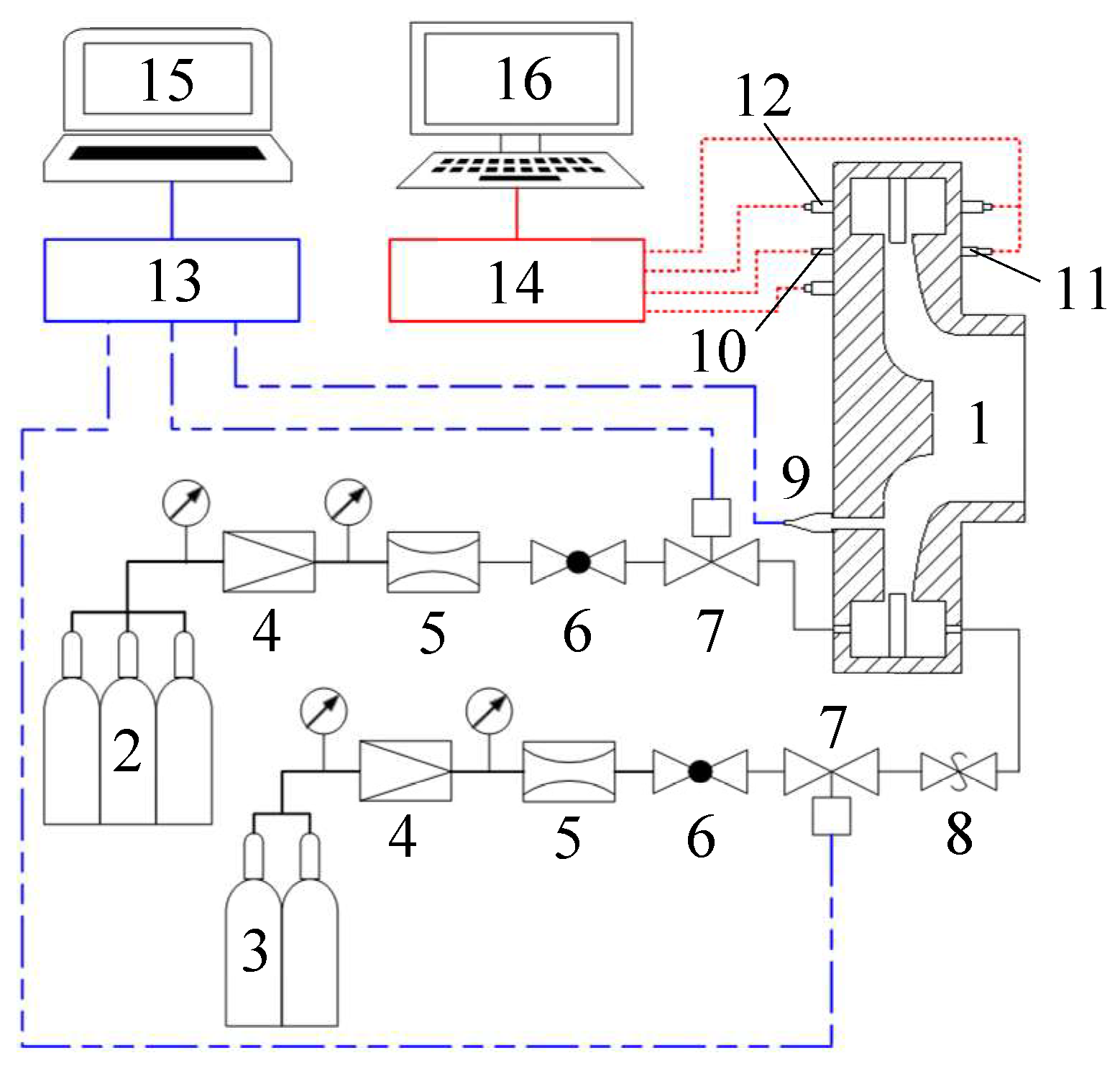
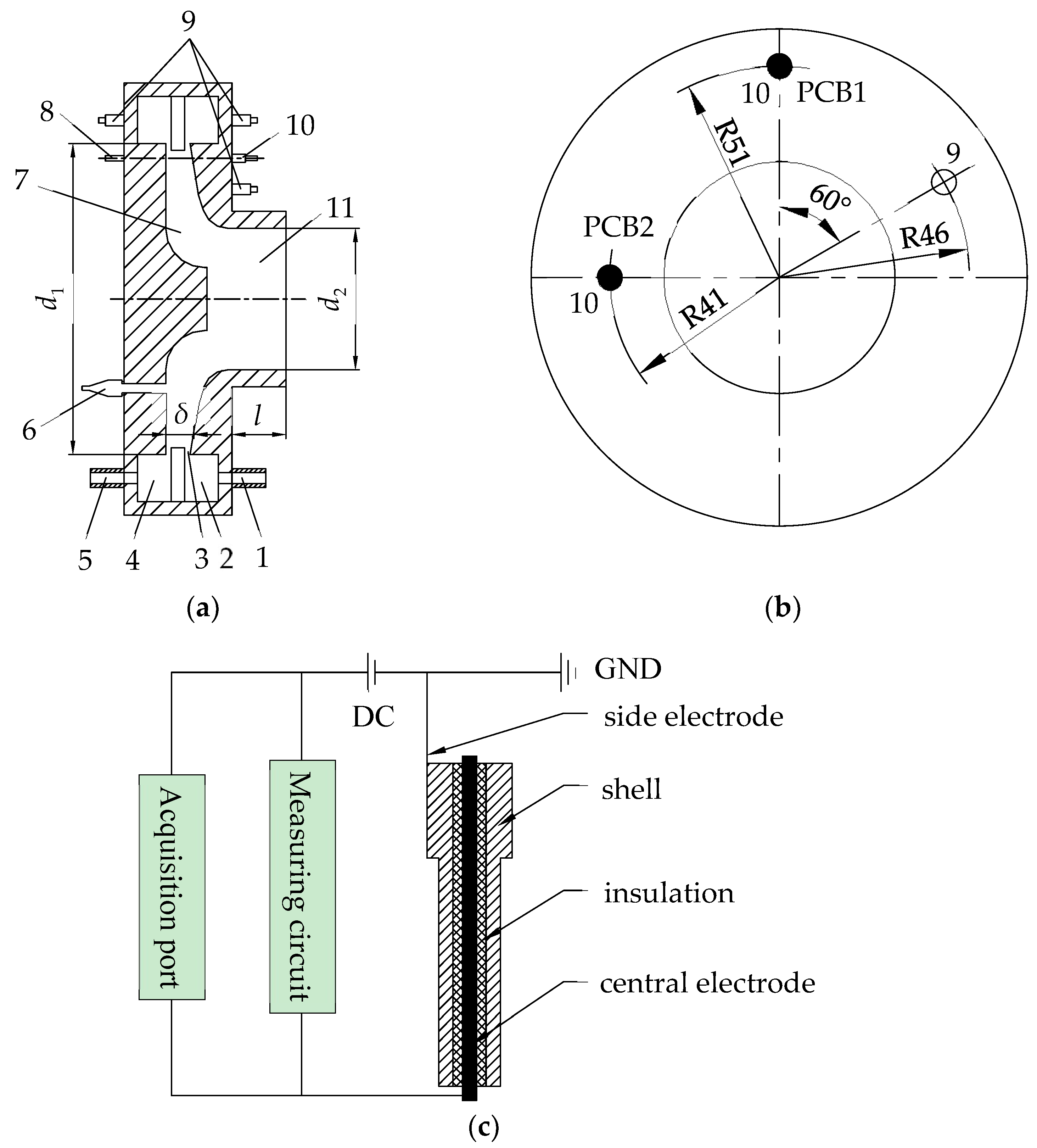
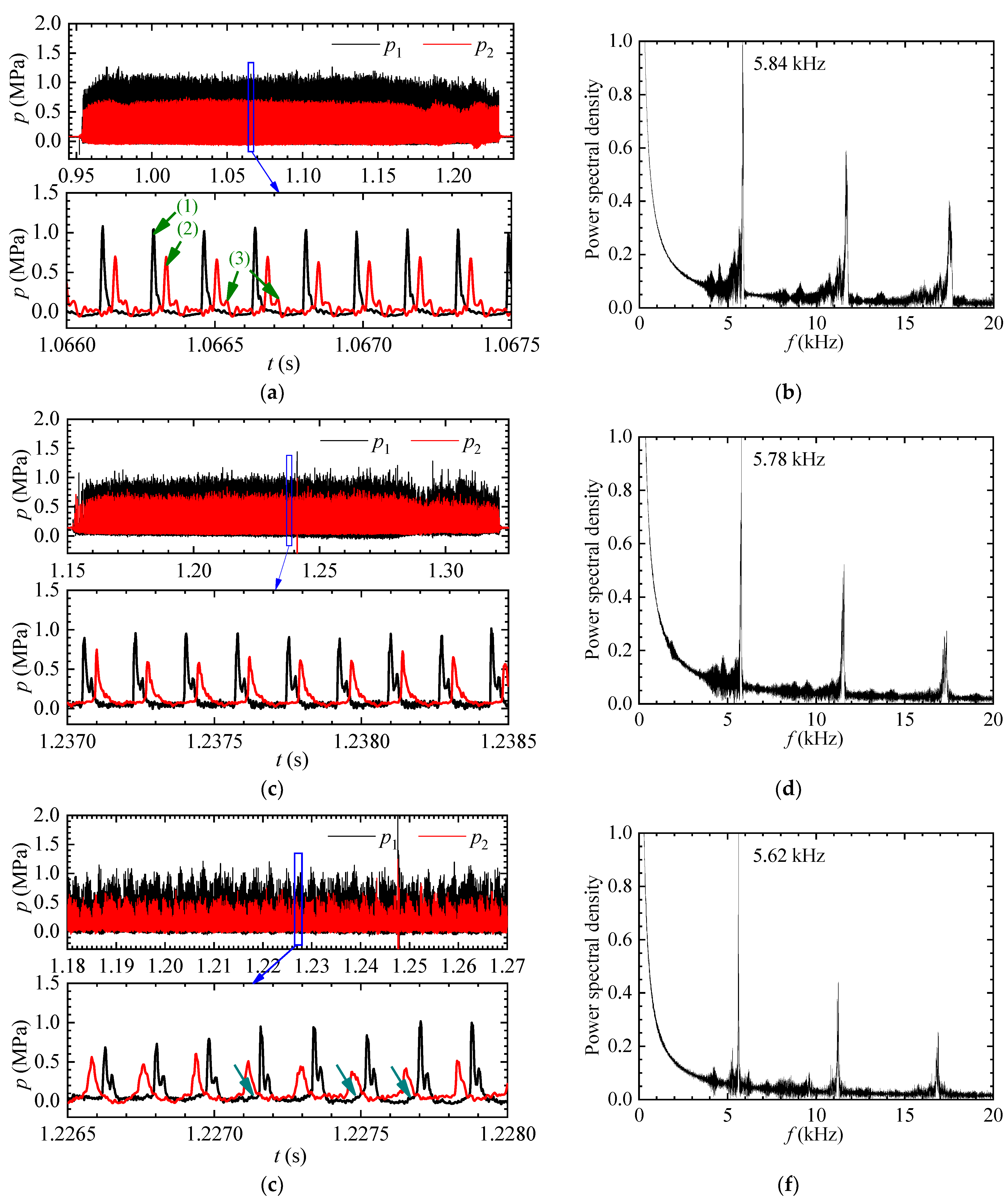

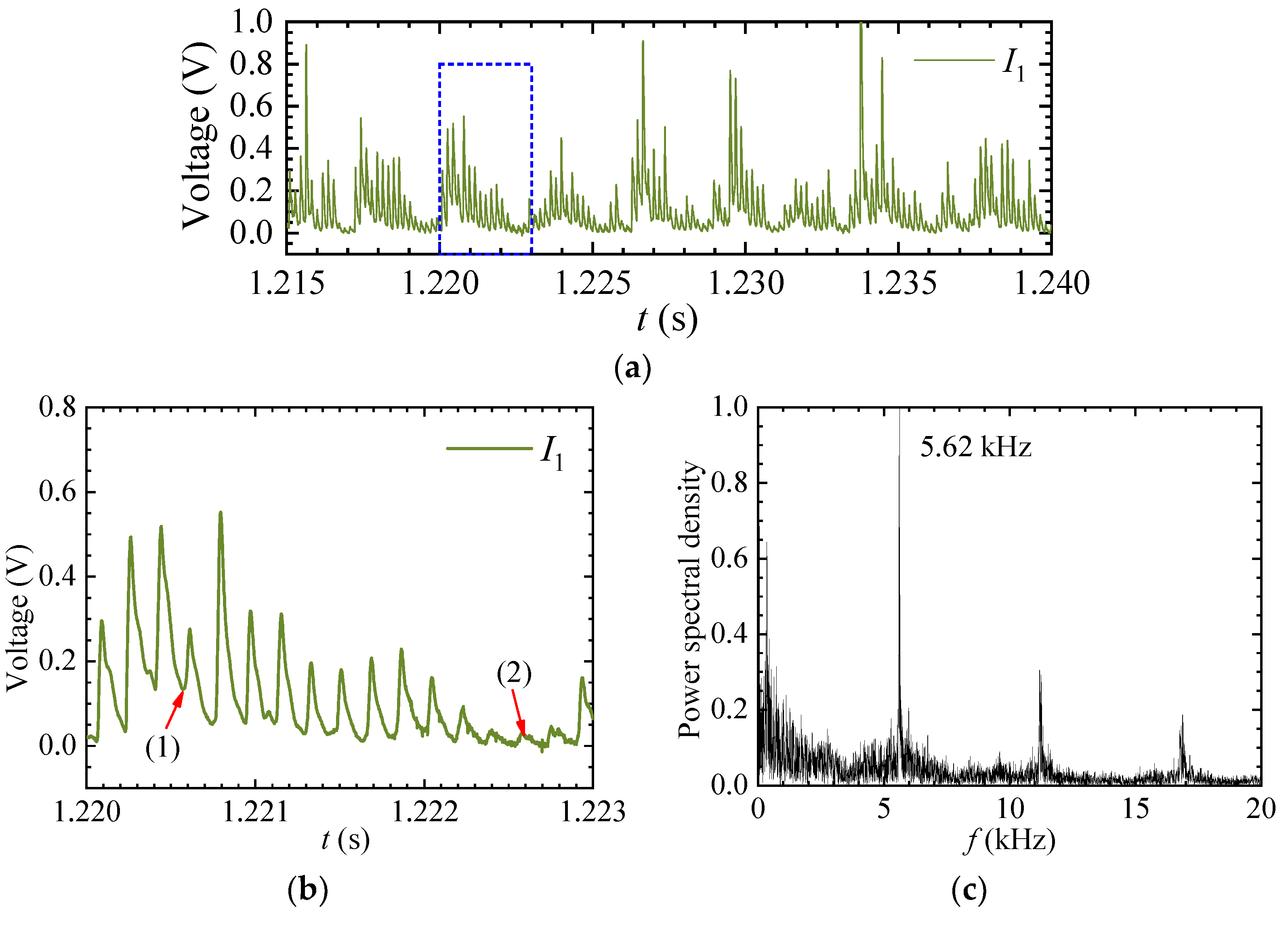
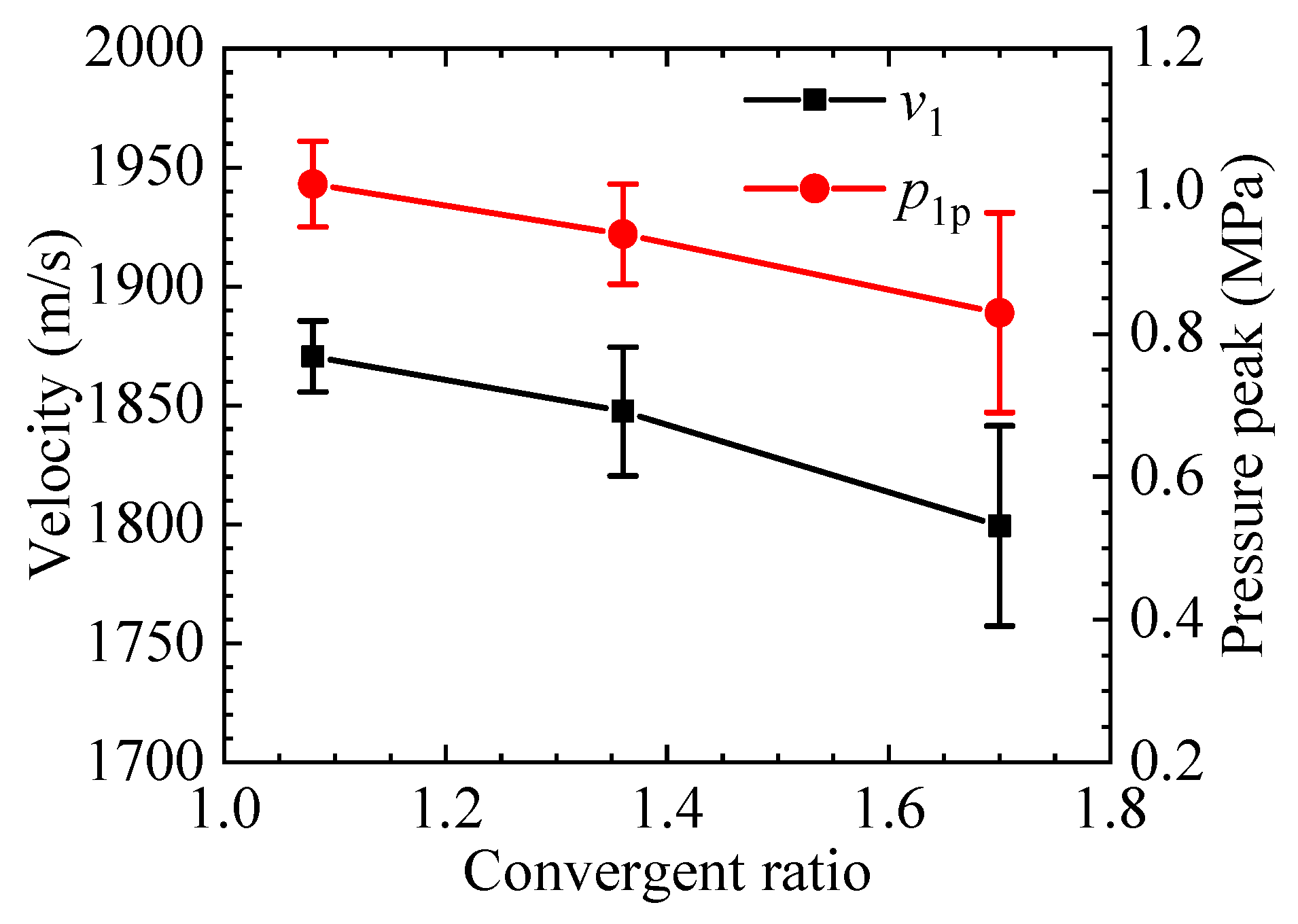

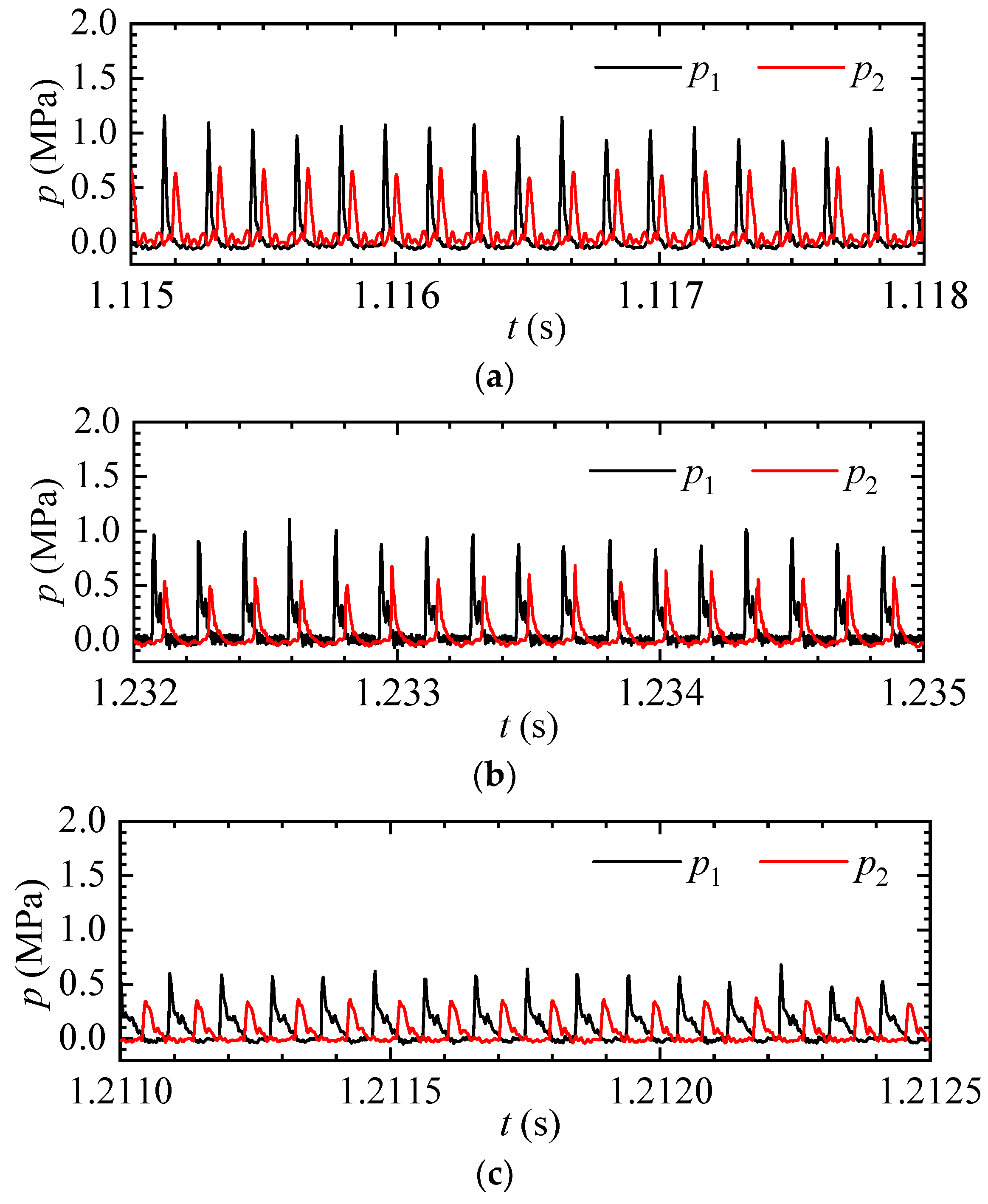
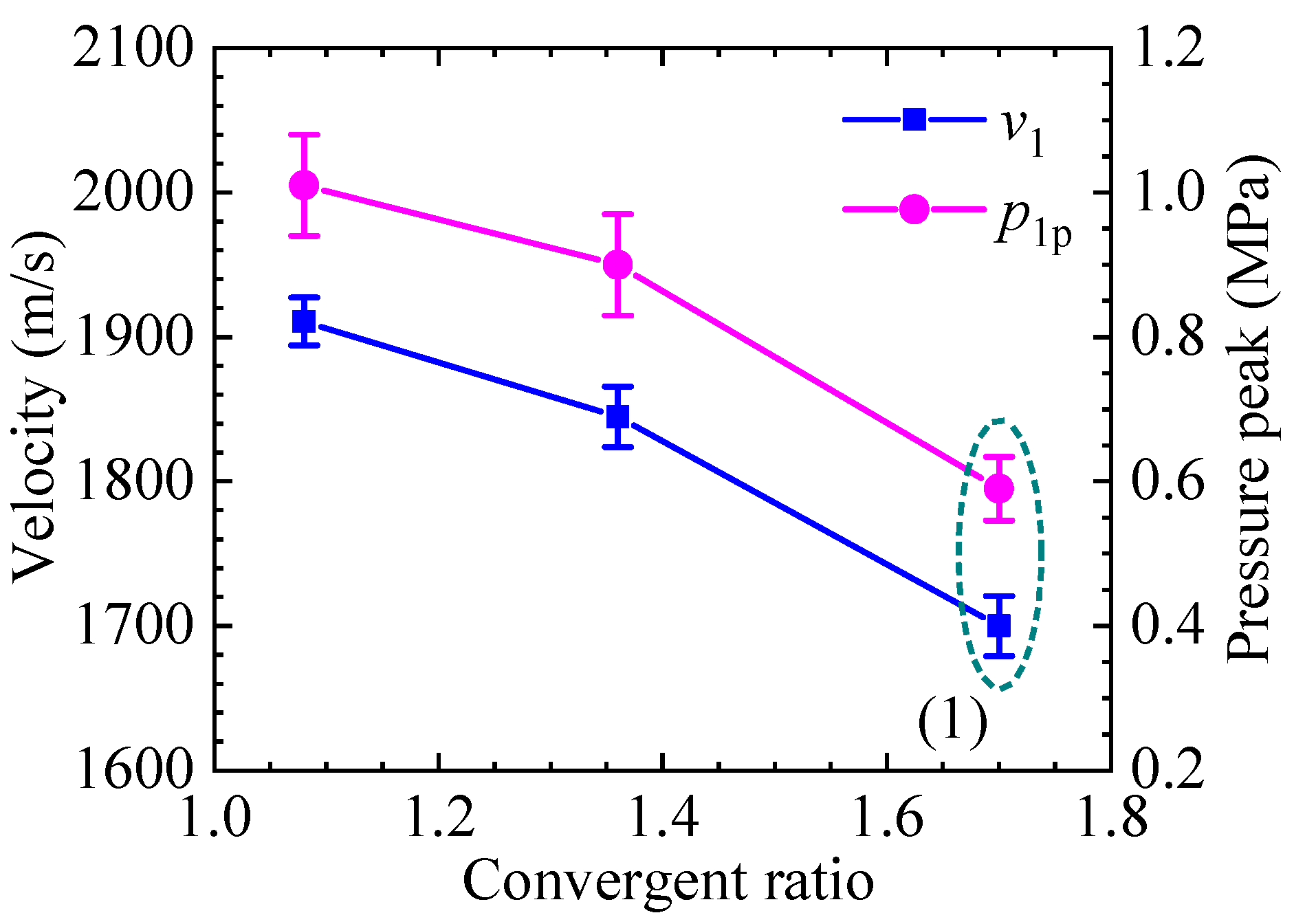
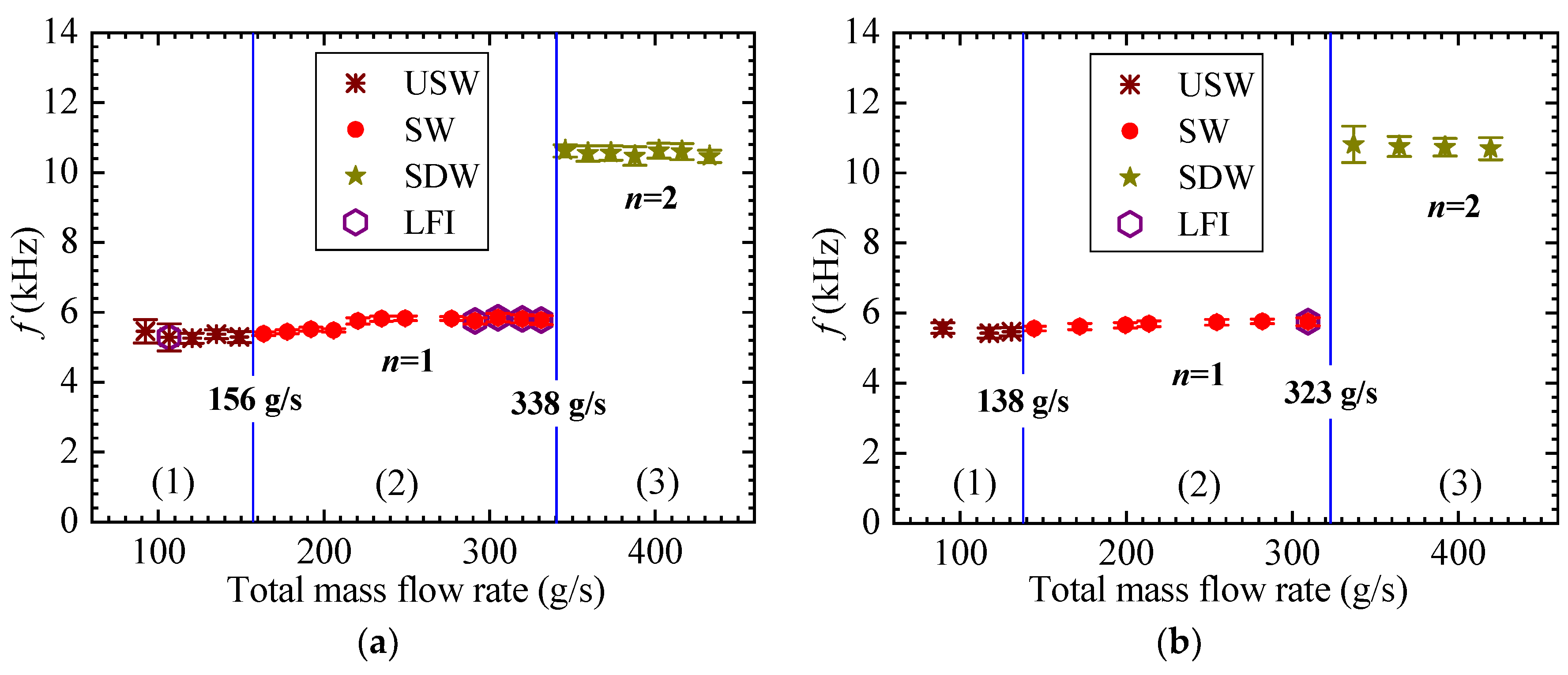
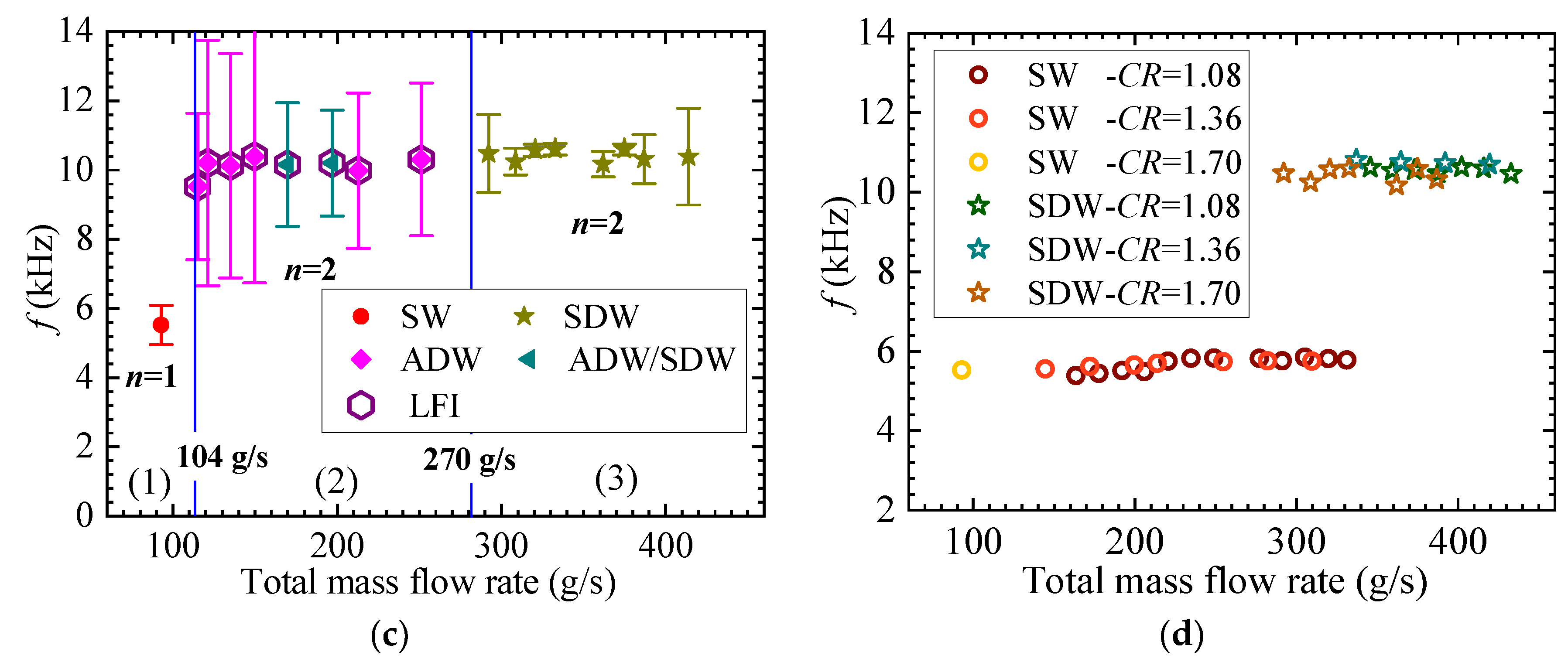

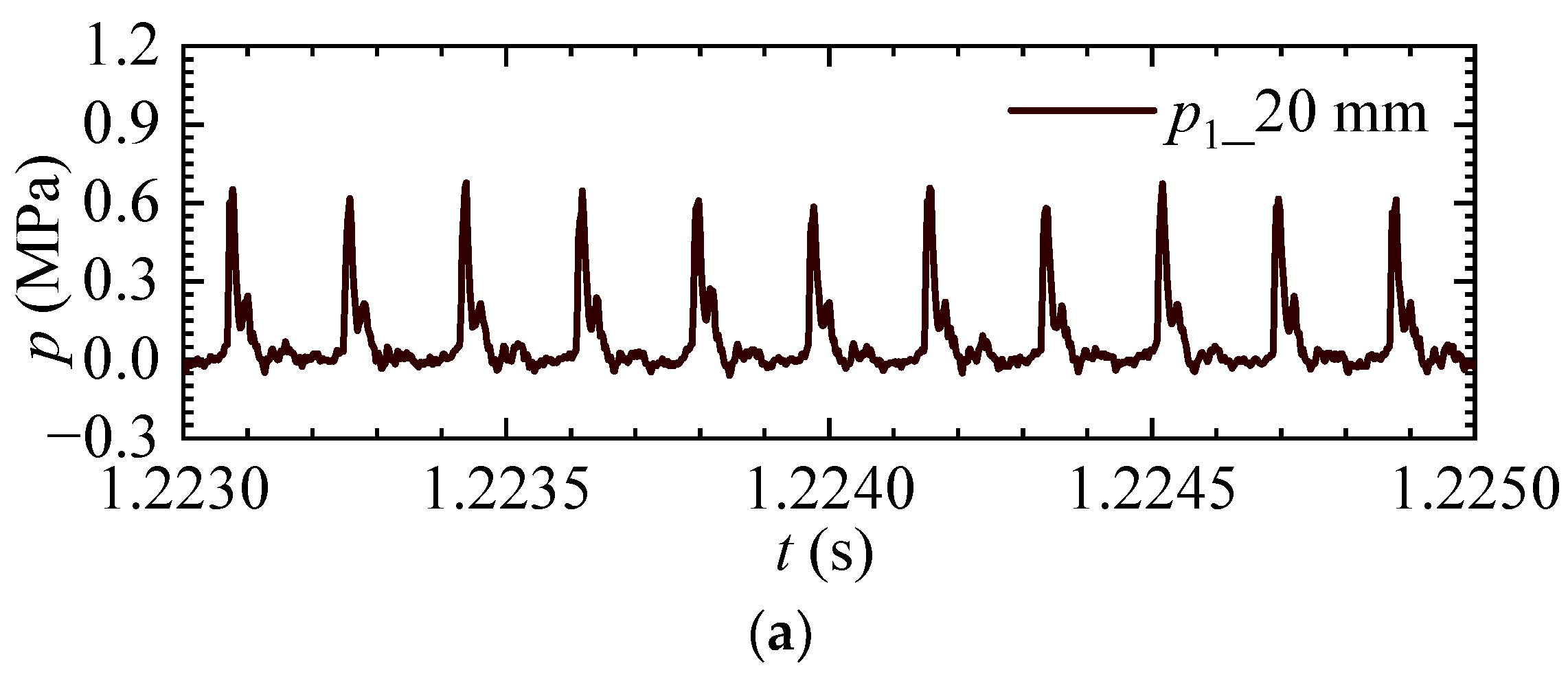
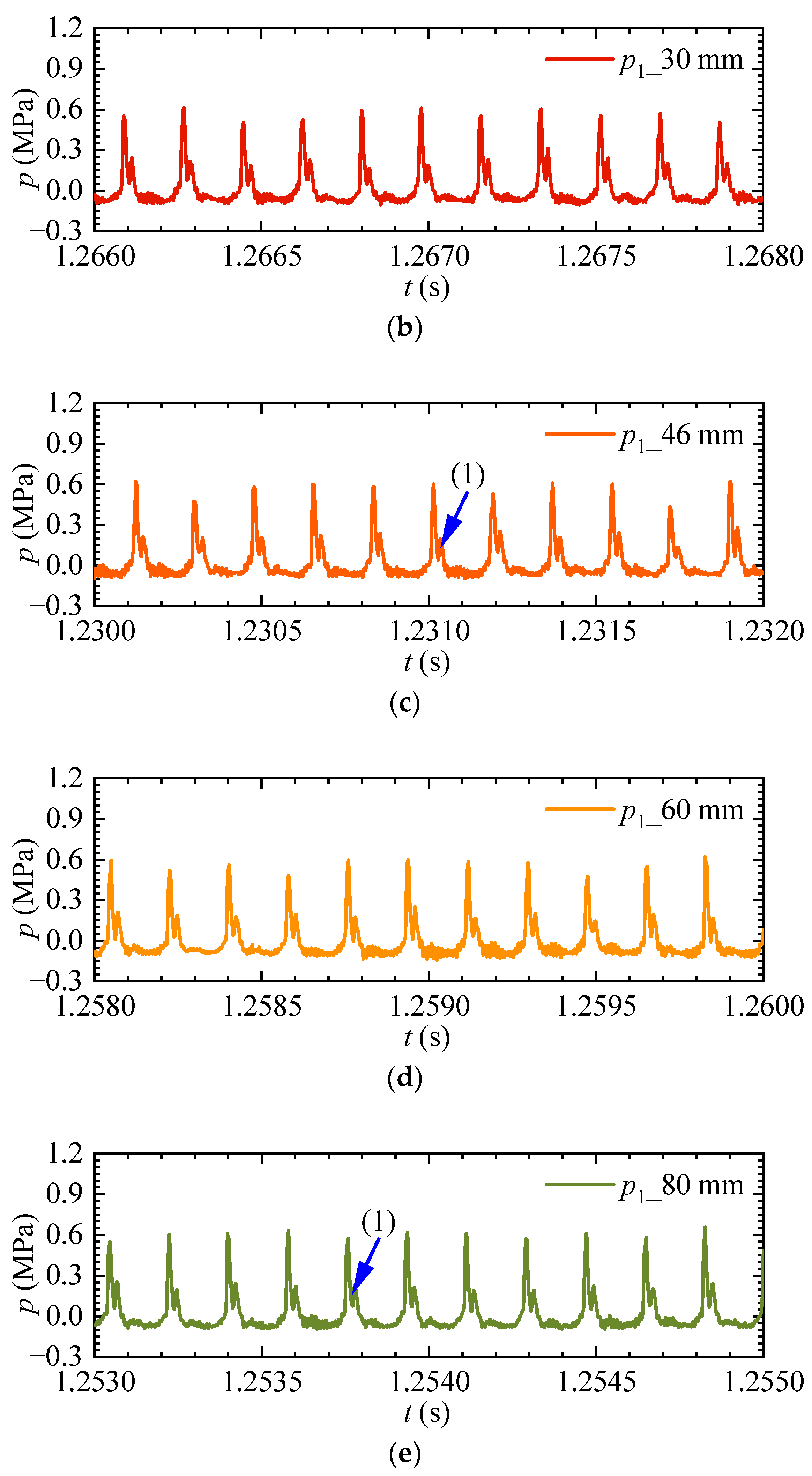

| No. | d1/mm | d2/mm | l/mm | Inlet Area/mm2 | Minimum Area/mm2 | Convergent Ratio |
|---|---|---|---|---|---|---|
| M1 | 120 | 56 | 46 | 2450.44 | 2277.19 | 1.08 |
| M2_3 | 120 | 50 | 46 | 2450.44 | 1805.19 | 1.36 |
| M3 | 120 | 46 | 46 | 2450.44 | 1441.52 | 1.7 |
| M2_1 | 120 | 50 | 20 | 2450.44 | 1805.19 | 1.36 |
| M2_2 | 120 | 50 | 30 | 2450.44 | 1805.19 | 1.36 |
| M2_4 | 120 | 50 | 60 | 2450.44 | 1805.19 | 1.36 |
| M2_5 | 120 | 50 | 80 | 2450.44 | 1805.19 | 1.36 |
| Case | Mass Flow Rate of H2 (g/s) | Mass Flow Rate of Air (g/s) | Equivalence Ratio (ER) | Convergent Ratio (CR) | Outlet Length (mm) | Mode |
|---|---|---|---|---|---|---|
| #1 | 9.5 | 206 | 1.58 | 1.08 | 46 | SW |
| #2 | 9.5 | 206 | 1.58 | 1.36 | 46 | SW |
| #3 | 9.5 | 206 | 1.58 | 1.70 | 46 | SW |
| #4 | 9.5 | 282 | 1.15 | 1.08 | 46 | SW |
| #5 | 9.5 | 282 | 1.15 | 1.36 | 46 | SW |
| #6 | 9.5 | 282 | 1.15 | 1.70 | 46 | SDW |
| #7 | 4.8 | 140 | 1.18 | 1.36 | 20 | SW |
| #8 | 4.8 | 140 | 1.18 | 1.36 | 30 | SW |
| #9 | 4.8 | 140 | 1.18 | 1.36 | 46 | SW |
| #10 | 4.8 | 140 | 1.18 | 1.36 | 60 | SW |
| #11 | 4.8 | 140 | 1.18 | 1.36 | 80 | SW |
Disclaimer/Publisher’s Note: The statements, opinions and data contained in all publications are solely those of the individual author(s) and contributor(s) and not of MDPI and/or the editor(s). MDPI and/or the editor(s) disclaim responsibility for any injury to people or property resulting from any ideas, methods, instructions or products referred to in the content. |
© 2023 by the authors. Licensee MDPI, Basel, Switzerland. This article is an open access article distributed under the terms and conditions of the Creative Commons Attribution (CC BY) license (https://creativecommons.org/licenses/by/4.0/).
Share and Cite
Xia, Z.; Ma, H.; Ge, G.; He, Y.; Zhou, C. Effect of Combustor Outlet Geometry on Operating Characteristics of Disk-Shaped Rotating Detonation Engine. Aerospace 2023, 10, 732. https://doi.org/10.3390/aerospace10080732
Xia Z, Ma H, Ge G, He Y, Zhou C. Effect of Combustor Outlet Geometry on Operating Characteristics of Disk-Shaped Rotating Detonation Engine. Aerospace. 2023; 10(8):732. https://doi.org/10.3390/aerospace10080732
Chicago/Turabian StyleXia, Zhenjuan, Hu Ma, Gaoyang Ge, Yong He, and Changsheng Zhou. 2023. "Effect of Combustor Outlet Geometry on Operating Characteristics of Disk-Shaped Rotating Detonation Engine" Aerospace 10, no. 8: 732. https://doi.org/10.3390/aerospace10080732






